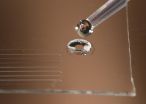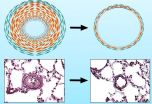(Press-News.org) When you flush the toilet, you may be discarding microscopic warning signs about your health.
But a cunningly simple new device can stop that vital information from "going to waste."
Brigham Young University chemist Adam Woolley and his students made a device that can detect markers of kidney disease and prostate cancer in a few minutes. All you have to do is drop a sample into a tiny tube and see how far it goes.
That's because the tube is lined with DNA sequences that will latch onto disease markers and nothing else. Urine from someone with a clean bill of health would flow freely through the tube (the farther, the better). But even at ultra-low concentrations, the DNA grabs enough markers to slow the flow and signal the presence of disease.
"In a disease state, this particular marker is equal to about one billionth of a percent of the content of urine." Woolley said. "We can detect close to those levels. If we can get below that, it would give us better sensitivity for somebody at an early stage of the disease."
Grad students Debolina Chatterjee and Danielle Mansfield co-authored the study for the journal Analytical Methods using synthetic urine samples. The next step is to do human trials with this "lab on a chip."
The method holds several advantages over current tests for prostate cancer: No blood draws, instant results and potentially higher accuracy.
Men who get their blood screened for a prostate specific antigen are really only learning whether their prostate is enlarged, and sometimes cancer is the cause.
But the BYU device works only when there is an exact match to a disease marker that is 22 RNA bases long. Harmless material that closely resembles the disease marker doesn't sound a false alarm.
"The flow distance is about 20 to 40 millimeters longer if just one of those 22 letters is wrong," Woolley said.
Although the new study specifically looked at prostate cancer and kidney disease, this same method could be used to make a diagnostic tool for other diseases.
"In a urine sample there can be millions of different sequences of micro-RNA and what we need to do is find the ones related to a disease," Woolley said.
INFORMATION: END
Prostate cancer, kidney disease detected in urine samples on the spot
New device uses DNA to latch onto disease markers
2014-10-27
ELSE PRESS RELEASES FROM THIS DATE:
Lack of transcription factor FoxO1 triggers pulmonary hypertension
2014-10-27
This news release is available in German.
Pulmonary hypertension is characterised by uncontrolled division of cells in the blood vessel walls. As a result, the vessel walls become increasingly thick.
Scientists at the Max Planck Institute for Heart and Lung Research in Bad Nauheim and Giessen University have discovered that transcription factor FoxO1 regulates the division of cells and plays a key role in the development of pulmonary hypertension. The researchers were able to cure pulmonary hypertension in rats by activating FoxO1. The study findings could ...
Study documents millions in unused medical supplies in US operating rooms each year
2014-10-27
A Johns Hopkins research team reports that major hospitals across the U.S. collectively throw away at least $15 million a year in unused operating room surgical supplies that could be salvaged and used to ease critical shortages, improve surgical care and boost public health in developing countries.
A report on the research, published online Oct. 16 in the World Journal of Surgery, highlights not only an opportunity for U.S. hospitals to help relieve the global burden of surgically treatable diseases, but also a means of reducing the cost and environmental impact of medical ...
Syracuse physicists closer to understanding balance of matter, antimatter in universe
2014-10-27
Physicists in Syracuse University's College of Arts and Sciences have made important discoveries regarding Bs meson particles—something that may explain why the Universe contains more matter than antimatter.
Distinguished Professor Sheldon Stone and his colleagues recently announced their findings at a workshop at CERN in Geneva, Switzerland. Titled "Implications of LHCb Measurements and Their Future Prospects," the workshop enabled him and other members of the Large Hadron Collider beauty (LHCb) Collaboration to share recent data results.
The LHCb Collaboration ...
Discovery of how newborn mice repair bone fractures could improve treatments
2014-10-27
If you've ever broken a bone, there's a good chance you needed surgery, braces, or splints to realign the bone. Severe fractures in infants, on the other hand, can heal on their own through a process that has eluded scientists. A study published by Cell Press on October 27 in Developmental Cell reveals that a fractured arm bone in newborn mice can rapidly realign through a previously unknown mechanism involving bone growth and muscle contraction. The findings provide new insights into how human infants and other young vertebrates may repair broken bones and pave the way ...
Ibuprofen better choice to relieve fracture pain in children than oral morphine
2014-10-27
Although Ibuprofen and oral morphine both provide effective pain relief for children with broken limbs, ibuprofen is the recommended choice because of adverse events associated with oral morphine, according to a randomized trial published in CMAJ (Canadian Medical Association Journal)
Fractures make up between 10% and 25% of all children's injuries, and the most severe pain is felt during the first 48 hours after the injury. Because of concerns about the safety of codeine for children, there is limited choice for medications to relieve pain for these patients.
"Evidence ...
New prostate cancer screening guideline recommends not using PSA test
2014-10-27
A new Canadian guideline recommends that the prostate-specific antigen (PSA) test should not be used to screen for prostate cancer based on evidence that shows an increased risk of harm and uncertain benefits. The guideline is published in CMAJ (Canadian Medical Association Journal)
"Some people believe men should be screened for prostate cancer with the PSA test but the evidence indicates otherwise," states Dr. Neil Bell, member of the Canadian Task Force on Preventive Health Care and chair of the prostate cancer guideline working group. "These recommendations balance ...
Imaging the genome: Cataloguing the fundamental processes of life
2014-10-27
The team of researchers, led by Dr Rafael Carazo Salas from the Department of Genetics, combined high-resolution 3D confocal microscopy and computer-automated analysis of the images to survey the fission yeast genome with respect to three key cellular processes simultaneously: cell shape, microtubule organisation and cell cycle progression. Microtubules are small, tube-like structures which help cells divide and give them their structure.
Of the 262 genes whose functions the team report in a study published today in the journal Developmental Cell, two-thirds are linked ...
New RCT: KoACT® beats calcium and vitamin D for optimal bone strength
2014-10-27
ity of Industry, CA – October 28, 2014 – A new randomized controlled trial (RCT) of post-menopausal women demonstrates that a proprietary blend of collagen and calcium, KoACT®, was far superior to calcium and vitamin D in slowing down the leaching of calcium from bones and rebuilding new bone strength. An Abstract of the article appears on PubMed at: http://www.ncbi.nlm.nih.gov/pubmed/25314004, ahead of print in The Journal of Medicinal Food.
The research was conducted by Bahram H. Arjmandi, PhD, RDN, who is currently Margaret A. Sitton Named Professor ...
GW researcher adapting breakthrough technologies to combat parasitic worm infections
2014-10-27
WASHINGTON (Oct. 27, 2014) — Recent breakthroughs may pave the way for vaccines and new drugs for those infected by parasitic helminths. These flatworms, including tapeworms that cause hydatid diseases and neurocysticercosis, liver flukes, and blood flukes (schistosomes), infect more than 300 million people and cause approximately four million disability-adjusted life years lost due to chronic illness and death each year.
Paul Brindley, Ph.D., professor of microbiology, immunology, and tropical medicine, and scientific director of the Research Center for Neglected ...
Boosting biogasoline production in microbes
2014-10-27
In the on-going effort to develop advanced biofuels as a clean, green and sustainable source of liquid transportation fuels, researchers at the U.S. Department of Energy (DOE)'s Joint BioEnergy Institute (JBEI) have identified microbial genes that can improve both the tolerance and the production of biogasoline in engineered strains of Escherichia coli.
Aindrila Mukhopadhyay, a chemist who directs the host engineering program for JBEI's Fuels Synthesis Division, led a study in which transcriptomic data and a synthetic metabolic pathway were used to identify several genes ...
LAST 30 PRESS RELEASES:
Normalizing blood sugar can halve heart attack risk
Lowering blood sugar cuts heart attack risk in people with prediabetes
Study links genetic variants to risk of blinding eye disease in premature infants
Non-opioid ‘pain sponge’ therapy halts cartilage degeneration and relieves chronic pain
AI can pick up cultural values by mimicking how kids learn
China’s ecological redlines offer fast track to 30 x 30 global conservation goal
Invisible indoor threats: emerging household contaminants and their growing risks to human health
Adding antibody treatment to chemo boosts outcomes for children with rare cancer
Germline pathogenic variants among women without a history of breast cancer
Tanning beds triple melanoma risk, potentially causing broad DNA damage
Unique bond identified as key to viral infection speed
Indoor tanning makes youthful skin much older on a genetic level
Mouse model sheds new light on the causes and potential solutions to human GI problems linked to muscular dystrophy
The Journal of Nuclear Medicine ahead-of-print tip sheet: December 12, 2025
Smarter tools for peering into the microscopic world
Applications open for funding to conduct research in the Kinsey Institute archives
Global measure underestimates the severity of food insecurity
Child survivors of critical illness are missing out on timely follow up care
Risk-based vs annual breast cancer screening / the WISDOM randomized clinical trial
University of Toronto launches Electric Vehicle Innovation Ontario to accelerate advanced EV technologies and build Canada’s innovation advantage
Early relapse predicts poor outcomes in aggressive blood cancer
American College of Lifestyle Medicine applauds two CMS models aligned with lifestyle medicine practice and reimbursement
Clinical trial finds cannabis use not a barrier to quitting nicotine vaping
Supplemental nutrition assistance program policies and food insecurity
Switching immune cells to “night mode” could limit damage after a heart attack, study suggests
URI-based Global RIghts Project report spotlights continued troubling trends in worldwide inhumane treatment
Neutrophils are less aggressive at night, explaining why nighttime heart attacks cause less damage than daytime events
Menopausal hormone therapy may not pose breast cancer risk for women with BRCA mutations
Mobile health tool may improve quality of life for adolescent and young adult breast cancer survivors
Acupuncture may help improve perceived breast cancer-related cognitive difficulties over usual care
[Press-News.org] Prostate cancer, kidney disease detected in urine samples on the spotNew device uses DNA to latch onto disease markers






